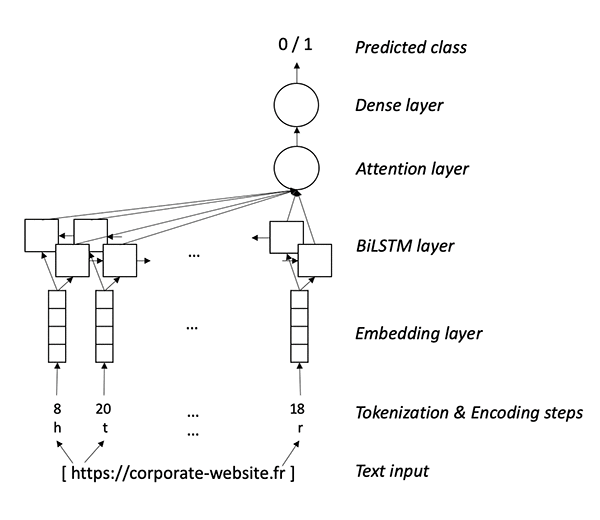How Euler Hermes detects typo squatting with Amazon SageMaker
This is a guest post from Euler Hermes. In their own words, “For over 100 years, Euler Hermes, the world leader in credit insurance, has accompanied its clients to provide simpler and safer digital products, thus becoming a key catalyzer in the world’s commerce.”
Euler Hermes manages more than 600,000 B2B transactions per month and effectuates data analytics from over 30 million companies worldwide. At-scale artificial intelligence and machine learning (ML) have become the heart of the business.
Euler Hermes uses ML across a variety of use cases. One recent example is typo squatting detection, which came about after an ideation workshop between the Cybersecurity and IT Innovation teams to better protect clients. As it turns out, moving from idea to production has never been easier when your data is in the AWS Cloud and you can put the right tools in the hands of your data scientists in minutes.
Typo squatting, or hijacking, is a form of cybersecurity attack. It consists of registering internet domain names that closely resemble legitimate, reputable, and well-known ones with the goal of phishing scams, identity theft, advertising, and malware installation, among other potential issues. The sources of typo squatting can be varied, including different top-level domains (TLD), typos, misspellings, combo squatting, or differently phrased domains.
The challenge we faced was building an ML solution to quickly detect any suspicious domains registered that could be used to exploit the Euler Hermes brand or its products.
To simplify the ML workflow and reduce time-to-market, we opted to use Amazon SageMaker. This fully managed AWS service was a natural choice due to the ability to easily build, train, tune, and deploy ML models at scale without worrying about the underlying infrastructure while being able to integrate with other AWS services such as Amazon Simple Storage Service (Amazon S3) or AWS Lambda. Furthermore, Amazon SageMaker meets the strict security requirements necessary for financial services companies like Euler Hermes, including support for private notebooks and endpoints, encryption of data in transit and at rest, and more.
Solution overview
To build and tune ML models, we used Amazon SageMaker notebooks as the main working tool for our data scientists. The idea was to train an ML model to recognize domains related to Euler Hermes. To accomplish this, we worked on the following two key steps: dataset construction and model building.
Dataset construction
Every ML project requires a lot of data, and our first objective was to build the training dataset.
The dataset of negative examples was composed of 1 million entries randomly picked from Alexa, Umbrella, and publicly registered domains, whereas the dataset of 1 million positive examples was created from a domain generated algorithm (DGA) using Euler Hermes’s internal domains.
Model building and tuning
One of the project’s biggest challenges was to decrease the number of false positives to a minimum. On a daily basis, we need to unearth domains related to Euler Hermes from a large dataset of approximately 150,000 publicly registered domains.
We tried two approaches: classical ML models and deep learning.
We considered various models for classical ML, including Random Forest, Logistic regression, and gradient boosting (LightGBM and XGBoost). For these models, we manually created more than 250 features. After an extensive feature-engineering phase, we selected the following as the most relevant:
- Number of FQDN levels
- Vowels ration
- Number of characters
- Bag of n-grams (top 50 n-grams)
- Features TF-IDF
- Latent Dirichlet allocation features
For deep learning, we decided to work with recurrent neural networks. The model we adopted was a Bidirectional LSTM (BiLSTM) with an attention layer. We found this model to be the best at extracting a URL’s underlying structure.
The following diagram shows the architecture designed for the BiLSTM model. To avoid overfitting, a Dropout layer was added.

The following code orchestrates the set of layers:
We built and tuned the classical ML and the deep learning models using the Amazon SageMaker-provided containers for Scikit-learn and Keras.
The following table summarizes the results we obtained. The BiLSTM outperformed the other models with a 13% precision improvement compared to the second-best model (LightGBM). For this reason, we put the BiLSTM model into production.
|
Models |
Precision | F1-Score |
ROC-AUC (Area Under the Curve) |
| Random Forest |
0.832 |
0.841 |
0.908 |
| XGBoost |
0.870 |
0.876 |
0.921 |
| LightGBM |
0.880 |
0.883 |
0.928 |
| RNN (BiLSTM) |
0.996 |
0.997 |
0.997 |
Model training
For model training, we made use of Managed Spot Training in Amazon SageMaker to use Amazon Elastic Compute Cloud (Amazon EC2) Spot Instances for training jobs. This allowed us to optimize the cost of training models at a lower cost compared to On-Demand Instances.
Because we predominantly used custom deep learning models, we needed GPU instances for time-consuming neural network training jobs, with times ranging from minutes to a few hours. Under these constraints, Managed Spot Training was a game-changing solution. The on-demand solution permitted no interruption of our data scientists while managing instance-stopping conditions.
Productizing
Euler Hermes’s cloud principles follow a serverless-first strategy, with an Infrastructure as Code DevOps practice. Systematically, we construct a serverless architecture based on Lambda whenever possible, but when this isn’t possible, we deploy to containers using AWS Fargate.
Amazon SageMaker allows us to deploy our ML models at scale within the same platform on a 100% serverless and scalable architecture. It creates a model endpoint that is ready to serve inference requests. To get inferences for an entire dataset, we use batch transform, which cuts the dataset off in smaller batches and gets the predictions on each one. Batch transform manages all the compute resources required to get inferences, including launching instances and deleting them after the batch transform job is complete.
The following figure depicts the architecture deployed for the use case in this post.

First, a daily Amazon CloudWatch event is set to trigger a Lambda function with two jobs: download all the publicly registered domains and store them in an Amazon Simple Storage Service (Amazon S3) bucket subfolder and trigger the BatchTransform job. Amazon SageMaker automatically saves the inferences in an S3 bucket that you specify when creating the batch transform job.
Finally, a second CloudWatch event monitors the task success of Amazon SageMaker. If the task succeeds, it triggers a second Lambda function that retrieves the inferred domains and selects those that have label 1—related to Euler Hermes or its products—and stores them in another S3 bucket subfolder.
Following Euler Hermes’s DevOps principles, all the infrastructure in this solution is coded in Terraform to implement an MLOps pipeline to deploy to production.
Conclusion
Amazon SageMaker provides the tool that our data scientists need to quickly and securely experiment and test while maintaining compliance with strict financial service standards. This allows us to bring new ideas into production very rapidly. With flexibility and inherent programmability, Amazon SageMaker helped us tackle our main pain point of industrializing ML models at scale. After we train an ML model, we can use Amazon SageMaker to deploy the model, and can automate the entire pipeline following the same DevOps principles and tools we use for all other applications we run with AWS.
In under 7 months, we were able to launch a new internal ML service from ideation to production and can now identify URL squatting fraud within 24 hours after the creation of a malicious domain.
Although our application is ready, we have some additional steps planned. First, we’ll extend the inferences currently stored on Amazon S3 to our SIEM platform. Second, we’ll implement a web interface to monitor the model and allow manual feedback that is captured for model retraining.
About the Authors
 Luis Leon is the IT Innovation Advisor responsible for the data science practice in the IT at Euler Hermes. He is in charge of the ideation of digital projects as well as managing the design, build and industrialization of at scale machine learning products. His main interests are Natural Language Processing, Time Series Analysis and non-supervised learning.
Luis Leon is the IT Innovation Advisor responsible for the data science practice in the IT at Euler Hermes. He is in charge of the ideation of digital projects as well as managing the design, build and industrialization of at scale machine learning products. His main interests are Natural Language Processing, Time Series Analysis and non-supervised learning.
 Hamza Benchekroun is Data Scientist in the IT Innovation hub at Euler Hermes focusing on deep learning solutions to increase productivity and guide decision making across teams. His research interests include Natural Language Processing, Time Series Analysis, Semi-Supervised Learning and their applications.
Hamza Benchekroun is Data Scientist in the IT Innovation hub at Euler Hermes focusing on deep learning solutions to increase productivity and guide decision making across teams. His research interests include Natural Language Processing, Time Series Analysis, Semi-Supervised Learning and their applications.
 Hatim Binani is data scientist intern in the IT Innovation hub at Euler Hermes. He is an engineering student at INSA Lyon in the computer science department. His field of interest is data science and machine learning. He contributed within the IT innovation team to the deployment of Watson on Amazon Sagemaker.
Hatim Binani is data scientist intern in the IT Innovation hub at Euler Hermes. He is an engineering student at INSA Lyon in the computer science department. His field of interest is data science and machine learning. He contributed within the IT innovation team to the deployment of Watson on Amazon Sagemaker.
 Guillaume Chambert is an IT security engineer at Euler Hermes. As SOC manager, he strives to stay ahead of new threats in order to protect Euler Hermes’ sensitive and mission-critical data. He is interested in developing innovation solutions to prevent critical information from being stolen, damaged or compromised by hackers.
Guillaume Chambert is an IT security engineer at Euler Hermes. As SOC manager, he strives to stay ahead of new threats in order to protect Euler Hermes’ sensitive and mission-critical data. He is interested in developing innovation solutions to prevent critical information from being stolen, damaged or compromised by hackers.
Tags: Archive

Leave a Reply